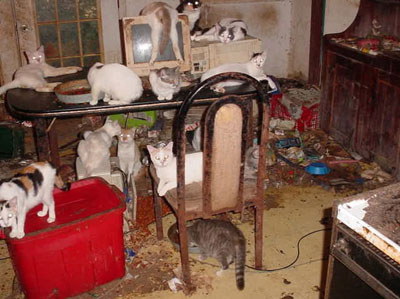Animal Hoarding
on 06/16/2011 07:07 in Features / 1 comment
Hoarders are sometimes classified as “pack rats” or “collectors”. Whatever you choose to call them, they are among the same mental illness of those with the compulsive need to hoard objects they desire. Some of these people collect mugs, others newspapers, but the most destructive of these hoarders collect animals.
A hoarder is defined as someone who collects objects of limited value, until they eventually takes over their living space. Most of us have probably known a hoarder or two within our lifetime. I knew a friend in college whose father would purchase several items of everything he liked. If he liked a certain jacket, he would get three of them, if he liked a microwave, he would buy four. He would use the excuse that he liked them so much, he wanted extras. He wasn’t fooling anybody though, he was a hoarder.
Like all mental illnesses, there are many levels of extremes. Miriam Sakewitz, (a.k.a. The Oregon Bunny Lady) and Barbara Woodley are two animal hoarders whose actions step away from the bounds of reasonable behavior.
Miriam Sakewitz and Barbara Woodley
Mirriam Sakewitz is no stranger to headlines. She was given the name “The Bunny Lady” back in October of 2006, when nearly 250 rabbits were confiscated from her home, including 100 found dead in the preservation of either her refrigerator or freezer. Eight months later, Sakewitz broke into the shelter were the surviving rabbits were being held, and stole them back. Police found her several days later with with 10 rabbits in her vehicle (2 dead), and another 130 stashed at a nearby horse farm. She was sentenced in April of 2007 to five years probation and forbid to go within 100 yards of another rabbit.
Barbara Woodley, a retired woman in her 60’s, owned a four acre plot of land, where she kept 300 dogs. The dogs were found in large buildings on the property, stacked-up in cages where they would remain indefinitely. When they were found, many of the dogs had sores on their body from being urinated on by the dogs in the top cages. Woodley threatened to shoot the veterinarian who was ordered by a judge to tend to the dogs who were in poor health. This was only the beginning of a three year court battle that would eventually free these suffering canines.
Theory Behind it and How to Help
One theory, is these people are suffering from attachment disorders that can often be traced back to their youth. Parental abuse may have left these individuals with only one form of companionship they could count on, their animals. These animals made them feel loved and secure. When these people then became adults, they continued to overcompensate for their troubles by hoarding new animals. Without realizing the harm they were causing, they continued to collect more animals, until they had more than they could handle.
If you think these are very isolated cases, you are wrong. There is estimated over 250,000 animals being hoarded in the United States right now. Many of these animals are living within the confines of some “eccentric cat lady,” and most people may not even realize the actual harm that is going on behind closed doors. It is important to recognize the signs of this sickness, and report such cases to the proper authorities before things get to the advanced stages of the above two stories. While these people may appear to love their animals, the problem is not love, it’s overcrowding.
Recent Posts
- Retirement Strategies
- Gold Takes a Backseat to Oil
- Silver Eagle Sales Gets a New Years Goose
- Australia May be an Upcoming REM Goldmine
- APMEX Joins eBay



0 Comments
You can be the first one to leave a comment.